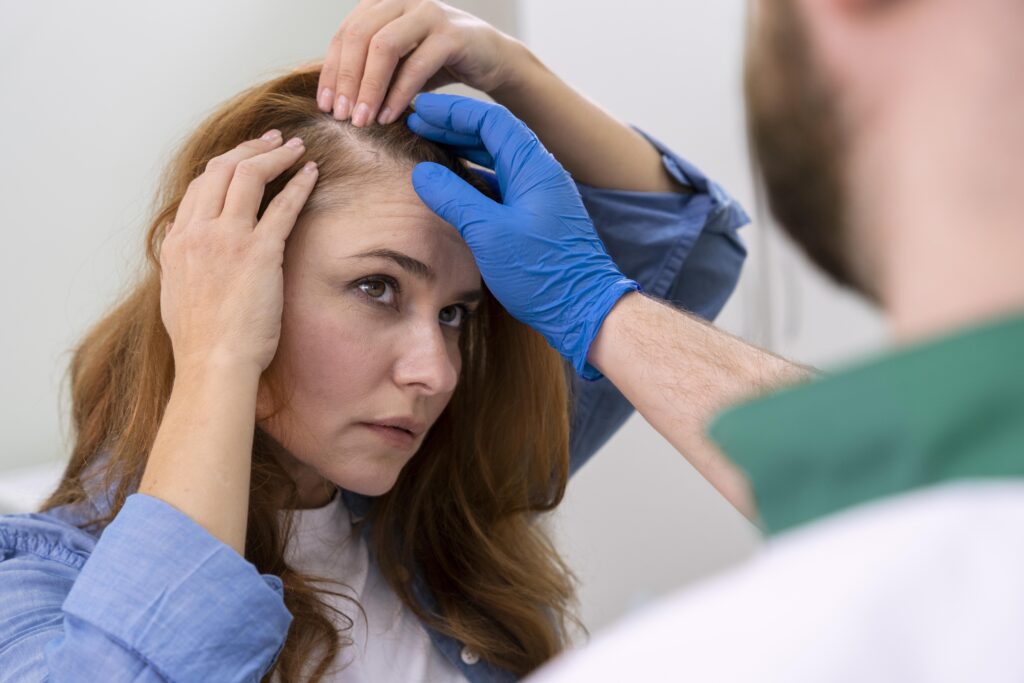Feminization surgery is a type of gender-affirming surgery that aims to create a more feminine appearance for transgender women. One of the most important aspects of feminization surgery is hair restoration, which can enhance the facial harmony and self-confidence of trans women. In this article, we will explain everything you need to know about hair restoration in feminization surgery, including the benefits, techniques, donor sites, postoperative care and surgical options. We will also introduce you to Dr.MFO clinic, which is one of the best places to get hair restoration in feminization surgery in Turkey.
Table of Contents
Scalp Feminization: Restoring a Feminine Hairline
The hairline is one of the most noticeable features that differentiate male and female faces. A typical male hairline is higher, straighter and more receding than a female hairline, which is lower, rounder and more forward. A male hairline can also have a prominent M-shaped pattern or widow’s peak, while a female hairline is more smooth and curved. Therefore, restoring a feminine hairline is a crucial step in scalp feminization, which is the process of creating a more feminine scalp shape and hair distribution.
Scalp feminization can be achieved by various surgical techniques, such as hair transplantation, scalp advancement or forehead reduction. Hair transplantation is the most common and effective technique for restoring a feminine hairline, as it allows for precise placement of individual hair follicles to create a natural and customized look. Scalp advancement or forehead reduction is a technique that involves removing excess skin from the forehead and advancing the scalp forward to lower the hairline. This technique can be combined with hair transplantation for optimal results.
Hair Transplant Techniques for Trans Women
Hair transplantation is a surgical procedure that involves moving hair follicles from one part of the body (donor site) to another (recipient site). The goal of hair transplantation is to restore or improve hair density, coverage and aesthetics. Hair transplantation can be performed on various areas of the body, such as scalp, eyebrows, eyelashes, beard, chest or pubic region. However, in this article, we will focus on hair transplantation for scalp feminization.
There are two main techniques for hair transplantation: follicular unit transplantation (FUT) and follicular unit extraction (FUE). FUT is a technique that involves removing a strip of skin from the back or sides of the scalp (donor area) and dissecting it into individual follicular units (groups of 1-4 hairs). These units are then implanted into tiny incisions made on the recipient area. FUE is a technique that involves extracting individual follicular units directly from the donor area using a specialized device. These units are then implanted into tiny incisions made on the recipient area.
Both techniques have their advantages and disadvantages. FUT can provide more grafts per session and higher survival rate of transplanted hairs, but it leaves a linear scar on the donor area that may be visible with short hairstyles. FUE can avoid a linear scar and allow for more flexibility in choosing the donor area, but it may result in lower graft yield and quality, and more damage to the donor area. The choice of technique depends on various factors, such as the patient’s preferences, goals, expectations, hair characteristics, donor availability and budget.
Donor Site Options for Hair Restoration
The donor site is the area of the body where hair follicles are harvested for transplantation. The donor site should have sufficient hair density, quality and compatibility with the recipient site. The most common donor site for hair restoration is the back or sides of the scalp, as these areas are usually resistant to hair loss and have similar hair characteristics to the recipient site. However, some patients may not have enough donor hair on their scalp due to genetic factors, previous surgeries or medical conditions. In such cases, alternative donor sites can be considered, such as beard, chest, abdomen, back, legs or arms.
The use of alternative donor sites has some advantages and disadvantages. The advantages are that it can increase the donor supply, provide more options for hair transplantation and create a more natural look by matching the hair texture and color of the recipient site. The disadvantages are that it can increase the risk of complications, such as infection, scarring, ingrown hairs or poor healing; reduce the quality and survival rate of transplanted hairs; and require more skill and experience from the surgeon. Therefore, alternative donor sites should be used with caution and only after a thorough evaluation and consultation with a qualified surgeon.
Postoperative Care for Transgender Hair Restoration
Postoperative care is an essential part of any surgical procedure, as it can affect the outcome and recovery of the patient. Postoperative care for transgender hair restoration involves following some instructions and precautions to ensure the proper healing and growth of the transplanted hairs. Some of the postoperative care tips are:
- Avoid touching, scratching or rubbing the transplanted area for at least 10 days after surgery.
- Keep the transplanted area clean and dry by washing it gently with a mild shampoo and patting it dry with a soft towel.
- Apply an antibiotic ointment or spray to the transplanted area as prescribed by your surgeon.
- Avoid strenuous activities, such as exercise, sports or heavy lifting, for at least 2 weeks after surgery.
- Avoid sun exposure, swimming, sauna or steam bath for at least 4 weeks after surgery.
- Wear a loose-fitting hat or scarf to protect the transplanted area from dust, wind or cold.
- Take painkillers, anti-inflammatory drugs or antibiotics as prescribed by your surgeon.
- Follow up with your surgeon regularly to monitor your progress and address any concerns or complications.
Addressing Hair Dysphoria Through Surgical Options
Hair dysphoria is a term that describes the distress or discomfort that some transgender people experience due to their hair not matching their gender identity. Hair dysphoria can affect various aspects of one’s life, such as self-esteem, social interactions, mental health and well-being. Hair dysphoria can be alleviated by various non-surgical or surgical options that can help transgender people achieve a more congruent and affirming appearance.
Non-surgical options include using wigs, hairpieces, extensions or accessories to create a desired hairstyle; using medications, such as finasteride or minoxidil, to prevent or slow down hair loss; or using cosmetic products, such as hair fibers or concealers, to camouflage thinning areas. Non-surgical options can provide temporary or partial solutions that can improve one’s appearance and confidence.
Surgical options include undergoing hair restoration procedures that can permanently restore or improve one’s hair density, coverage and aesthetics. Surgical options can provide more definitive and satisfying solutions that can transform one’s appearance and identity. Surgical options include scalp feminization techniques that can create a more feminine hairline; hair transplantation techniques that can fill in balding or thinning areas; eyebrow transplantation techniques that can enhance the shape and density of eyebrows; eyelash transplantation techniques that can lengthen and thicken eyelashes; beard transplantation techniques that can remove unwanted facial hair; or body hair transplantation techniques that can add or remove body hair.

Conclusion: Hair Restoration in Feminization Surgery
Hair restoration in feminization surgery is a valuable option for transgender women who want to achieve a more feminine appearance and overcome their hair dysphoria. Hair restoration in feminization surgery can offer various benefits, such as improving facial harmony, boosting self-confidence, enhancing quality of life and supporting gender transition. Hair restoration in feminization surgery can be performed by different techniques, such as hair transplantation, scalp advancement or forehead reduction. Hair restoration in feminization surgery requires careful planning, evaluation and consultation with a qualified surgeon who has experience and expertise in this field.
If you are looking for a reliable and reputable clinic to get hair restoration in feminization surgery in Turkey, you should consider Dr.MFO clinic. Dr.MFO clinic is one of the leading providers of feminization surgery in Turkey, offering high-quality services at affordable prices.
Dr.MFO clinic has a team of experienced and skilled surgeons who specialize in hair restoration in feminization surgery. Dr.MFO clinic uses the latest technology and equipment to ensure the safety and satisfaction of their patients. Dr.MFO clinic offers a variety of hair restoration techniques, such as FUT, FUE, beard, eyebrow, eyelash or body hair transplantation. Dr.MFO clinic also provides other feminization surgery procedures, such as facial feminization surgery, breast augmentation, body contouring or genital reconstruction.
Dr.MFO clinic is located in Antalya, which is a beautiful and popular tourist destination in Turkey. Antalya has a warm and sunny climate, a rich history and culture, and a vibrant nightlife. Antalya also has many attractions and activities to enjoy, such as beaches, parks, museums, shopping malls or restaurants. Antalya is easily accessible by air, land or sea from anywhere in the world.
Dr.MFO clinic offers a comprehensive package for their international patients, which includes airport transfers, hotel accommodation, medical consultations, surgery fees, medications, postoperative care and follow-up visits. Dr.MFO clinic also provides a personal assistant who can help with language translation, travel arrangements or any other needs. Dr.MFO clinic guarantees the privacy and confidentiality of their patients at all times.
If you are interested in getting hair restoration in feminization surgery at Dr.MFO clinic, you can contact them through their website here or by phone at +905528003322. You can also request a free online consultation by filling out a simple form here. Dr.MFO clinic will respond to your inquiry as soon as possible and provide you with all the information and guidance you need.
FAQ
How long does hair restoration in feminization surgery take?
The duration of hair restoration in feminization surgery depends on the technique used and the number of grafts transplanted. Generally, hair transplantation can take from 4 to 8 hours, while scalp advancement or forehead reduction can take from 2 to 4 hours.
How much does hair restoration in feminization surgery cost?
The cost of hair restoration in feminization surgery varies depending on the technique used, the number of grafts transplanted, the surgeon’s fees and the clinic’s location. In Turkey, hair restoration in feminization surgery is much more affordable than in other countries, such as the USA or Europe. The average cost of hair transplantation in Turkey ranges from $2,000 to $4,000 USD, while the average cost of scalp advancement or forehead reduction ranges from $3,000 to $5,000 USD.
What are the risks and complications of hair restoration in feminization surgery?
Hair restoration in feminization surgery is generally safe and effective, but like any surgical procedure, it carries some risks and complications. Some of the possible risks and complications are:
- Infection
- Bleeding
- Swelling
- Bruising
- Scarring
- Numbness
- Pain
- Itching
- Inflammation
- Necrosis
- Cysts
- Graft failure
- Poor growth
- Unnatural appearance
These risks and complications can be minimized by choosing a qualified surgeon who has experience and expertise in hair restoration in feminization surgery; following the preoperative and postoperative instructions carefully; and reporting any problems or concerns to your surgeon immediately.
When will I see the results of hair restoration in feminization surgery?
The results of hair restoration in feminization surgery are not immediate, but gradual and progressive. The transplanted hairs will initially fall out within a few weeks after surgery, but this is normal and expected. The new hairs will start to grow after 3 to 4 months and reach their full length and density after 9 to 12 months. The final results of hair restoration in feminization surgery will be visible after one year.
How long will the results of hair restoration in feminization surgery last?
The results of hair restoration in feminization surgery are permanent, as the transplanted hairs are resistant to the effects of hormones that cause hair loss. However, some factors may affect the longevity and quality of the results, such as aging, lifestyle habits or medical conditions. Therefore, it is important to maintain a healthy diet, exercise regularly, avoid smoking or alcohol consumption, protect your scalp from sun damage or trauma and follow up with your surgeon regularly.





